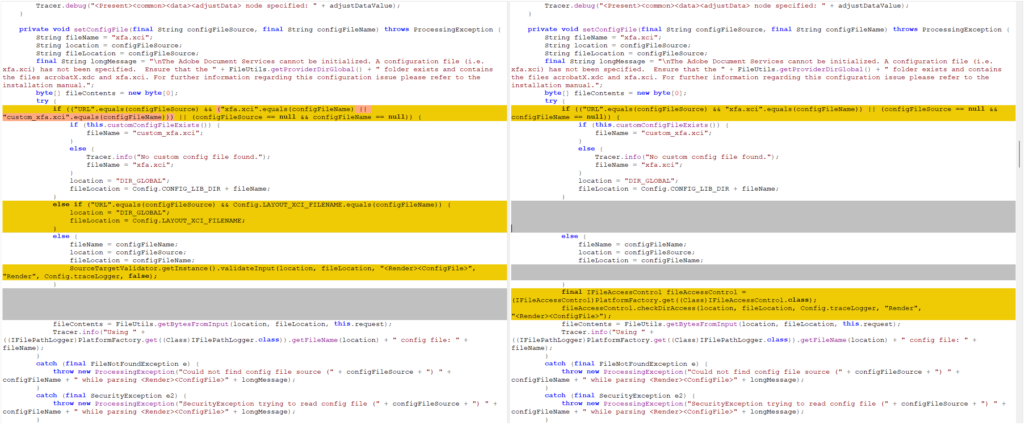SAP NetWeaver: On December 10, 2024, SAP published Security Note 3536965, which resolves several high-severity vulnerabilities found in the Adobe Document Services component of SAP NetWeaver AS for JAVA. Tracked as CVE-2024-47578, CVE-2024-47579, and CVE-2024-47580, these vulnerabilities present serious threats to organizations relying on SAP’s enterprise platforms. In this blog post, we examine the details of these vulnerabilities, their potential impact, and the critical measures organizations must take to mitigate the associated risks.
Vulnerability Overview and Analysis
The primary vulnerability, CVE-2024-47578, is a Server-Side Request Forgery (SSRF) issue that enables an attacker with administrative privileges to send specially crafted requests from a compromised web application. Such attacks typically target internal systems shielded by firewalls, making them inaccessible from external networks. If successfully exploited, this vulnerability could allow an attacker to read, alter, or delete files on the server, or even render the entire system inoperable, potentially causing major disruptions to business operations.
Alongside CVE-2024-47578, two additional vulnerabilities have been identified. CVE-2024-47579 allows an authenticated attacker with administrative rights to exploit an exposed web service to upload or download customized PDF font files to the system server. By manipulating this functionality, an attacker can embed internal server files within font files and retrieve them, gaining access to sensitive data without compromising system integrity or availability. Similarly, CVE-2024-47580 enables an authenticated attacker to generate PDFs containing embedded attachments sourced from internal server files. By downloading these PDFs, the attacker can access any file on the server, again without affecting the system’s overall integrity or availability.
More: Zero-Day (CVE-2024-41730) Exploited by Initial Access Brokers
Consequences and Exposure
Together, these vulnerabilities pose significant threats to the security and integrity of SAP environments. Unauthorized access to sensitive files can result in data breaches, exposing confidential business information, intellectual property, and personal data. The SSRF vulnerability is especially dangerous, as it can be used to launch further attacks within the internal network, potentially compromising additional systems and services. Moreover, the ability to stealthily manipulate and access internal files weakens the organization’s overall security posture, heightening the risk of regulatory non-compliance, substantial financial penalties, and serious reputational harm.
Proof of Concept
Proof of concept and vulnerability signatures are deployed in the RedRays Security Platform.

Strategies for Mitigation and Recovery
Effectively addressing these vulnerabilities demands immediate and decisive action. Organizations should promptly apply SAP Security Note 3536965, updating Adobe Document Services to the specified patch level. This update delivers essential fixes to safeguard against the identified vulnerabilities. It is critical to implement this patch without delay across all impacted SAP NetWeaver AS for JAVA instances, particularly in environments with heightened exposure to threats.
Following the update, comprehensive testing should be performed to confirm that the vulnerabilities have been properly mitigated and that system functionality remains intact. It is also advisable to review system and application logs for any signs of attempted exploitation prior to patch deployment. Strengthening security further involves enforcing the principle of least privilege for administrative access and implementing multi-factor authentication (MFA) on all administrative accounts, thereby reducing the risk of unauthorized actions.
Additionally, network segmentation plays a key role in defense. Isolating SAP NetWeaver AS for JAVA from other parts of the network helps minimize the attack surface and restricts lateral movement by attackers. Updating firewall rules to tightly control inbound and outbound traffic to and from Adobe Document Services provides another layer of protection.
To maintain a strong security posture over time, organizations should conduct regular security audits, including vulnerability assessments and penetration testing. These proactive measures ensure that defenses remain robust and that any newly emerging vulnerabilities are identified and addressed swiftly.
Maintaining a Strong Security Posture
Maintaining a strong security posture requires continuous awareness of the latest SAP Security Notes and updates to stay ahead of evolving threats. Implementing automated patch management processes can help streamline the deployment of critical updates across all SAP environments, minimizing the window of vulnerability. Additionally, educating employees on security best practices and the importance of maintaining secure system configurations is crucial for fostering a culture of security awareness across the organization.
Establishing and regularly updating a comprehensive incident response plan is equally vital. A well-prepared plan enables organizations to respond swiftly and effectively to security breaches, minimizing potential damage and ensuring a rapid return to normal operations.
Conclusion
The vulnerabilities identified in SAP NetWeaver AS for JAVA’s Adobe Document Services — CVE-2024-47578, CVE-2024-47579, and CVE-2024-47580 — underscore the critical importance of proactive cybersecurity practices within SAP environments. These flaws could lead to serious data breaches, system disruptions, and significant regulatory and reputational consequences.
Organizations must act swiftly by applying SAP’s recommended patches, reinforcing security controls, and adopting a defense-in-depth approach to minimize risk. Beyond immediate remediation, maintaining an ongoing focus on vulnerability management, user education, and incident preparedness is essential to safeguarding enterprise systems against current and future threats.
By staying vigilant and prioritizing security at every level, organizations can not only protect their SAP infrastructure but also strengthen overall business resilience in an increasingly complex threat landscape.

